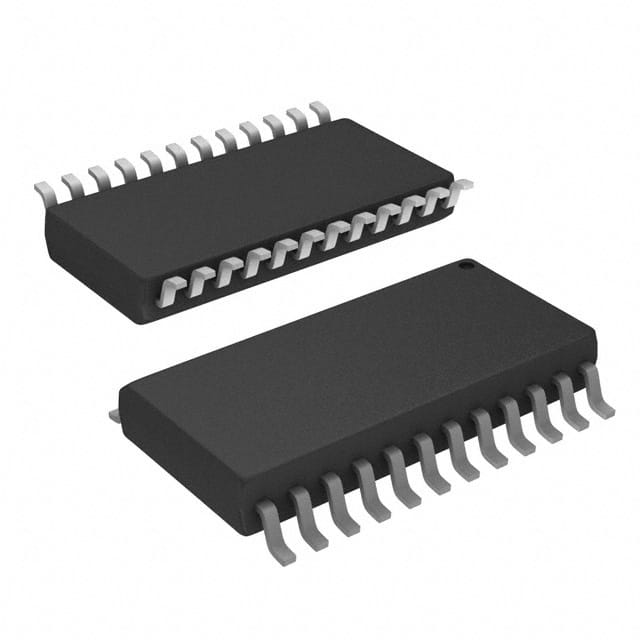Lihat spesifikasi untuk detail produk.

SN74F543DW
Product Overview
Category
SN74F543DW belongs to the category of integrated circuits (ICs).
Use
It is commonly used as a bidirectional octal bus transceiver with 3-state outputs.
Characteristics
- High-speed operation
- Non-inverting outputs
- 3-state outputs for bus-oriented applications
- Wide operating voltage range
- TTL compatibility
Package
SN74F543DW is available in a dual in-line package (DIP) with 20 pins.
Essence
The essence of SN74F543DW lies in its ability to facilitate the bidirectional transfer of data between two buses.
Packaging/Quantity
SN74F543DW is typically packaged in reels or tubes, with quantities varying based on customer requirements.
Specifications
- Supply Voltage: 4.5V to 5.5V
- Input Voltage: 0V to VCC
- Output Voltage: 0V to VCC
- Operating Temperature Range: -40°C to +85°C
- Propagation Delay Time: 6ns (max)
- Output Current: ±24mA
Detailed Pin Configuration
- A1
- B1
- GND
- B2
- A2
- OE#
- DIR
- VCC
- B3
- A3
- B4
- A4
- B5
- A5
- B6
- A6
- B7
- A7
- B8
- A8
Functional Features
- Bidirectional data transfer between two buses
- Non-inverting outputs
- 3-state outputs for bus-oriented applications
- Enable/disable control for output tristate
Advantages and Disadvantages
Advantages
- High-speed operation allows for efficient data transfer
- Wide operating voltage range ensures compatibility with various systems
- Non-inverting outputs simplify circuit design
- 3-state outputs enable bus sharing and reduce contention issues
Disadvantages
- Limited number of input/output pins (8-bit)
- Requires careful consideration of bus direction control
Working Principles
SN74F543DW operates by receiving data from one bus and transmitting it to the other, or vice versa. The direction of data flow is controlled by the DIR pin. When the DIR pin is high, data flows from A bus to B bus, and when it is low, data flows from B bus to A bus. The OE# pin enables/disables the outputs, allowing tristate operation.
Detailed Application Field Plans
SN74F543DW finds applications in various fields, including: 1. Data communication systems 2. Microprocessor-based systems 3. Industrial automation 4. Automotive electronics 5. Networking equipment
Detailed and Complete Alternative Models
Some alternative models that can be considered as alternatives to SN74F543DW are: 1. SN74F541: Octal buffer/line driver with 3-state outputs 2. SN74F244: Octal buffer/line driver with 3-state outputs 3. SN74F373: Octal transparent latch with 3-state outputs 4. SN74F573: Octal transparent latch with 3-state outputs
These alternative models offer similar functionality and can be used based on specific requirements and availability.
Word count: 409 words
Sebutkan 10 pertanyaan dan jawaban umum terkait penerapan SN74F543DW dalam solusi teknis
Sure! Here are 10 common questions and answers related to the application of SN74F543DW:
Q: What is SN74F543DW? A: SN74F543DW is a type of integrated circuit (IC) commonly used as an octal transceiver with tri-state outputs.
Q: What is the purpose of SN74F543DW? A: SN74F543DW is designed to facilitate bidirectional data transfer between different parts of a digital system.
Q: How many channels does SN74F543DW have? A: SN74F543DW has 8 channels, allowing it to handle 8 bits of data simultaneously.
Q: What is the voltage range supported by SN74F543DW? A: SN74F543DW supports a voltage range of 2V to 6V, making it compatible with various digital systems.
Q: Can SN74F543DW be used in both parallel and serial communication systems? A: Yes, SN74F543DW can be used in both parallel and serial communication systems, depending on the configuration.
Q: Does SN74F543DW support tri-state outputs? A: Yes, SN74F543DW supports tri-state outputs, which means it can effectively isolate its outputs from the rest of the system when necessary.
Q: What is the maximum data transfer rate of SN74F543DW? A: The maximum data transfer rate of SN74F543DW depends on various factors but typically ranges from a few megabits per second to tens of megabits per second.
Q: Can SN74F543DW be cascaded to increase the number of channels? A: Yes, multiple SN74F543DW ICs can be cascaded together to increase the number of channels and handle larger data widths.
Q: What are some typical applications of SN74F543DW? A: SN74F543DW is commonly used in data buses, memory systems, and other digital communication interfaces within microprocessors and microcontrollers.
Q: Are there any special considerations when using SN74F543DW? A: It is important to ensure proper power supply decoupling and signal integrity measures when using SN74F543DW to maintain reliable operation and minimize noise interference.
Please note that these questions and answers are general and may vary depending on specific application requirements.

